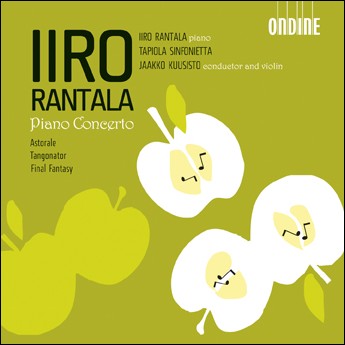Fuse Commentary Drill Down: Iiro Rantala’s “Concerto in G-sharp / A-flat”
Fuse Jazz Critic Steve Elman is currently surveying works that illuminate the tradition of the jazz-influenced piano concerto. His series began with an examination of Chick Corea’s current recording, The Continents. In part two, he takes a look at eight works by jazz composers that precede the release of Corea’s work. This post is a detailed examination of one of the works discussed in part two.
Iiro Rantala: Concerto in G-sharp / A-flat (2002 – 2005), partially scored by Jaako Kuusisto (Rantala’s brother-in-law) – Rantala, p; Tapiola Sinfonietta; Kuuisto, cond / v [Rec. 5/05, Tapiola Hall, Espoo, Finland; Ondine CD, 2006]
Movement I
Starts with parody of tuning, led by oboe, then led by piano, leading into parody of modern clusters – all these jokes lead to some string scratches like katydids.
Theme introduced over the scratches, which finally are silent. “Open” feeling for winds (a Sibelianesque pastorale?) leads into first piano passage – lots of motion, into a quasi-march.
Piano appearance – hammering like Gershwin, then Prokoviev, then Stravinskyish repetition (echoes of John Adams too).
Expansive theme returns in brass with rich low bass harmony, showing off a beautiful theme decorated at end by trumpet.
A “dance theme” is introduced, with some spiky harmony in strings – pizzicato stuff leads into something that is almost neo-classical, with plenty of crisp, snappy writing, but not swinging in a jazz sense.
Next passage is one of the best so far, with plenty of variety and “intuitive” forward motion. An exuberant dialogue between orchestra and piano follows.
Clarinet brings back the expansive theme, then a piano cadenza, probably improvised, with very impressive fingerwork from Rantala.
Return to the trumpet line for a “heroic” transition to plenty of staccato stuff without fixed harmony.
“Joky” bassoon with flute and winds – a hint of “Peter and the Wolf”
Then, another piano passage, again sounding improvised, with triangle accompaniment, that moves into a flash of directly jazzy music. This moves into Rachmaninoff-like piano arpeggiations with full orchestra, romantic and soaring, over mechanical effects from the orchestra. This is something of a battle, which the piano almost wins.
The mechanical effects are then explored more fully. There’s a bit of call-and-response between soloist and ensemble. This is a tense prelude to an appealing resolution section for piano and orchestra, bringing a lot of the elements together – slipping back to jokes, a suggestion of a pop tune, some hints of Richard Strauss (Till Eulenspiegel), big piano arpeggios over ominous pedal point, some mechanical stuff, the trumpet tune, and a very sudden end on a sort of dissonant chord, forte – yet another joke.
Movement II
The introduction, from the strings, could be the opening bars of a Chopin-y pop tune. The solo piano passage that follows is very Chopin / Bill Evans-ish, with winds joining in.
Then the strings introduce a somewhat darker mood. The piano takes the lead in a 3/4 dance section, again like Stravinsky, from his neo-classical period.
There’s an oboe – clarinet dialogue in a romantic vein, and then the piano returns, with the orchestra evoking the swells of Rachmaninoff or even Tchaikovsky, rather heart-on-sleeve, but with a wink
Conclusion of the movement is really lovely, with another sudden end.
Movement III
A solo piano passage begins the movement, possibly improvised, at least in part, drawing from the impressionists and Gershwin, with a quick fillip towards a “Russian” motif. Then there’s some Shostakovich-like grotesquerie in piano, decorated with a schmaltzy tremolo.
The mechanical hammering effects from the first movement return, and there is a full working out of previous material with soloist and orchestra.
This mood is sustained as the music becomes more joky and western, sliding toward a pastiche of jazzy cliches for a minute or so, a quick hit of swing tempo. Then we hear the orchestra by itself, in a much sweeter mood, with a hint of slow swing and a couple of solo violin passages.
The burlesque-Russian mood returns, and then the sweet strings again, without apparent irony.
Three Gershwin-like arpeggios from piano lead into more neo-classical a la Prokoviev. A big virtuoso piano transition leads into an orchestral passage of near-swing, “sound-effects,” and a somber horn solo over the strings (R Strauss again).
Then a sprightly dancing piano theme with some darker commentary from orchestra. This slides towards an almost-dance-hall moment where you expect a big Broadway show tune to emerge. There are some Bill Evans-y piano accents with lovely string support. This “suspended feel” section is ear-grabbing.
But this is paid off with a much denser section, harmonies slipping all around without fixed tonality, lead passed all around the orchestra – one of the best moments in the piece, very expressive. Then the piano returns gently over a vibraphone ostinato that is really lovely, with string support.
This is abandoned for a big energetic transition back to the Shostakovich theme, with a Fletcher Henderson big-band end-of-tune joke right in the middle of it.
The piano “takes a breath” for the finale, which draws Gershwin and Prokoviev into the mix. There is a little feint towards a bombastic Shostakovich ensemble, then back into joky territory – with a hint of Walter Schumann’s “Dragnet” theme. After a Rachmaninoff-like solo passage, the big Broadway show tune hinted at earlier makes a full-fledged appearance, but tongue-in-cheek.
The piano cadenza has plenty of references to what’s gone before. This is so cohesive that it sounds like it was through-composed rather than improvised. A phony Beethovenish ending leads right back into conversation between piano and orchestra on the “Russian” theme.
The final bars: fast and jumpy, a sudden resolution, a final piano chord with orchestra, and a soft Bronx cheer from a muted trombone.


